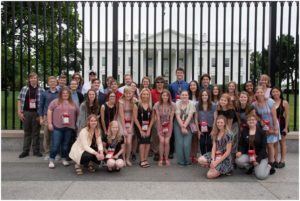NRECA 2022 Washington DC Youth Tour Journal
By Savannah Berg
 I
I ’m writing this in my hotel room, on a hot Wednesday night. My window blinds are open, and I must say, the view is quite different from home. The horizon… Well, the horizon is hidden by towering buildings of brick and stone. I cannot see the stars, but lights from the adjacent hotel room windows, car-lights, and street lamps checkered and light the dark outside all the same. The city isn’t quite like my country home, either; there’s a constant hum of cars on the road below.
’m writing this in my hotel room, on a hot Wednesday night. My window blinds are open, and I must say, the view is quite different from home. The horizon… Well, the horizon is hidden by towering buildings of brick and stone. I cannot see the stars, but lights from the adjacent hotel room windows, car-lights, and street lamps checkered and light the dark outside all the same. The city isn’t quite like my country home, either; there’s a constant hum of cars on the road below.
It’s different, but I don’t mind it. It’s riveting and exciting. I feel so happy here. The people I have met, from Arizona to Florida– We were brought together because of one common theme in our lives: We are powered by rural electric cooperatives. But, we were brought together as friends on our own accord. By our willingness to reach out, and open ourselves up to new people. Our interests, goals, and political activeness made us close.
That and the united partying power of the Floridians and Texans. Noise complaints be damned, no future party I attend will ever top that first night in DC when nearly 200 southern teenagers broke open the most awkward kids and led them in the dance party of the century.
 Overall, the people I have met are by far the best part of the trip. I’ve met and made friends with unique and interesting people from all across the country. And my heart is heavy when I think about parting ways with them.
Overall, the people I have met are by far the best part of the trip. I’ve met and made friends with unique and interesting people from all across the country. And my heart is heavy when I think about parting ways with them.
But I know we will stay in contact, and I know I will never forget this opportunity I shared with all of them. However, to help keep my memory fresh and to show you my perspectives throughout this journey, I would like to walk you through my thoughts on the places we visited…
Our first stop was the Vietnam Memorial, which holds a lot more power in person. With every step along the side of The Wall, as you descend to the corner point, you begin to feel a weight on your shoulders. Each step, every name read, every flower passed– It all weighs down on you, and slowly lifts as you exit upwards.
The Three Servicemen memorial, so beautifully made, overlooks The Wall. The disturbance and despair on the bronze soldier’s face as he looks at the names upon names of his fallen comrades. On the other side, the Women’s Memorial, honoring the female servicewomen of Vietnam. The center nurse, cradling a wounded, dying soldier in her arms, is reminiscent of Mother Mary holding Jesus beneath the cross.
Every aspect of the memorial, and the different members of the war effort it represented, was powerful and full of meaning. It was by far one of my favorite memorials.
The Korean Memorial was smaller, as is the memory of the war. 19 soldiers walk the grounds of the memorial, staring off around them, searching for the enemy forever- more. It is like PTSD incarnated. Real faces of soldiers are etched into the wall along the side of the soldiers. A few of them, I was just tall enough to look in the eye– My own reflection staring back at me through their carved eyes. I stood there a while, studying their eyes, their faces, their expressions. It’s hard to gauge who they are, when all that is left is their face on the reflective, black granite. I’m not sure why I tried so hard to understand them more, but I don’t regret doing so.
The World War Two memorial affected me a bit more. A few months ago, I learned of my great-uncle’s service in WW2, and how he was  one of the first to lose his life aboard the SS Leopoldville, a battleship torpedoed and sunk by a German submarine in a Belgian channel. Initially I was ashamed that I, and few other family, knew or remembered how we lost this ancestor.
one of the first to lose his life aboard the SS Leopoldville, a battleship torpedoed and sunk by a German submarine in a Belgian channel. Initially I was ashamed that I, and few other family, knew or remembered how we lost this ancestor.
 Seeing the memorial, without even knowing it existed, made me feel better about this circumstance. The columns, the fountains, the stars– An entire memorial dedicated to the thousands of men and women lost in a war that raged across the world; And my great-uncle Edwin was one of those men lost. And even if I didn’t remember him, there was an entire memorial dedicated to men like him.
Seeing the memorial, without even knowing it existed, made me feel better about this circumstance. The columns, the fountains, the stars– An entire memorial dedicated to the thousands of men and women lost in a war that raged across the world; And my great-uncle Edwin was one of those men lost. And even if I didn’t remember him, there was an entire memorial dedicated to men like him.
I may have forgotten, but everyone who created and visited the memorial didn’t. Everyone who visited, who paid their respects, didn’t forget him. I am indebted to those people, a debt I won’t be able to repay. And that’s why these memorials matter. Because no matter what, the lost lives of our nation will always be remembered by someone.
At the Jefferson Memorial, the sun was beginning to set over The Basin. The Washington Memorial and the Martin Luther King memorial are visible on opposite banks. The roman-style monument was peaceful and had beautiful views. The Basin reminded me of home, of times at cabins on the lake.
I laid down beside the shore. To one side of me, was the soft rumble of the cars, buses, and the regular noises of the city life so new to me; To the other side, wildlife and the sounds of waves that I was so used to; And I was the bridge between the two worlds, the different atmospheres of two rivaling forms of life colliding and connecting within me.
I’m not big into mindfulness. I can’t sit still long enough to meditate. But if I could sit at Jefferson Memorial  all day, and feel the way I did that evening, I would.
all day, and feel the way I did that evening, I would.
The Holocaust Museum gave me goosebumps before I even walked in the door. I was terrified of what cruelty I would see when I toured the exhibits, and my fear was validated. Every step pulled back the corner of a curtain ever so slightly, revealing the pitfalls of mankind and the monsters among us.
So much disturbed me inside the museum; I saw and heard things I wish I hadn’t. One of the most disturbing parts for me was viewing the exhibits in the silent space, and the only noise was the old videos, which filled the rooms with the sound of Hitler and his followers chanting in praise and victory– Echoing and shattering your soul with every shout.
And somehow, that’s the easiest part for me to talk about. In two hours, I witnessed shootings, decapitations and dismemberment, 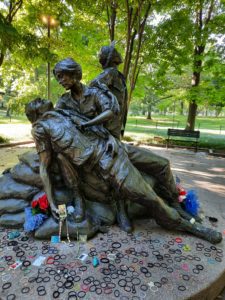 bodies bulldozed into pits; I saw faces upon faces of victims, and faces upon faces of monsters. It was reeling. Almost torturous to have to see, but nowhere near as torturous as for those who had to live through it.
bodies bulldozed into pits; I saw faces upon faces of victims, and faces upon faces of monsters. It was reeling. Almost torturous to have to see, but nowhere near as torturous as for those who had to live through it.
The 9/11 Memorial at the Pentagon made me tremble before I even entered. I felt a weight similar to what I felt at the Vietnam memorial, but this one was more… apparent. More painful. Unlike the scar of the Vietnam memorial, this memorial represents a scar on our country only 20 years old, and one that is still painful.
I was born after 9/11. Because of that, I’ve never known a peaceful world. I’ve known war, violence, and paranoia. I’ve known hatred for the people of the Middle East, and fear of injury and death in most public places in which I stepped. I grew up seeing the same despair on the adults’ faces as they recall their memory of that day.
I carried a weight within the memorial. I wanted to cry– For the people lost, for the people who carry the burden of memory, for the inno cent lives tarnished and ruined, for my generation being born into such terrifying circumstances and times. But I didn’t want to cry. I wanted to help heal. So, I read as many of the victims’ names as I could that night. It wasn’t much, but it was the least I could do.
cent lives tarnished and ruined, for my generation being born into such terrifying circumstances and times. But I didn’t want to cry. I wanted to help heal. So, I read as many of the victims’ names as I could that night. It wasn’t much, but it was the least I could do.
The grounds of Mount Vernon are as beautiful as they are rumored to be. Overlooking the Potomac River, surrounded by forests and gardens, the land which Washington called home is simply stunning. Every building, no matter how small, is a wonderful work of art, and the views of the natural world are peaceful and so different from the cities around it.
 I felt as though I understood aspects of Washington more as I toured the home. I understood his eagerness to return home after the Revolutionary War, his love of nature and farming, his calm and charismatic nature. The house is magnificent, yet simple and welcoming, a reflection of our first president’s personality.
I felt as though I understood aspects of Washington more as I toured the home. I understood his eagerness to return home after the Revolutionary War, his love of nature and farming, his calm and charismatic nature. The house is magnificent, yet simple and welcoming, a reflection of our first president’s personality.
However, the beauty of the land was overshadowed by an undeniable fact: When the land was in its prime, it was a plantation that enslaved over 300 men, women, and children. Reading and learning the stories of these people, and seeing the conditions they lived in, made it harder and harder to not view Washington in a different light.
I know it was acceptable at the time, and therefore we are not supposed to judge too harshly because they  didn’t know better. I disagree to an extent. Washington will still have my respect as a great general and leader of the free world. I will honor him as a founding father, and for his part in building our nation.
didn’t know better. I disagree to an extent. Washington will still have my respect as a great general and leader of the free world. I will honor him as a founding father, and for his part in building our nation.
But on a personal, moral level, my respect is lost. To progress as a society, we must stop turning a blind eye to the monstrous actions of our predecessors, lest we refuse to evolve and move forward. I will honor, but I will not idolize a man who committed such wrongs, and forget the people he wronged.
Because of this, I loved the trip to Mount Vernon; Not only for the beauty, but for the lessons it taught me.
 The location of the National Cathedral overlooks downtown DC, in its stunning beauty of architecture. It towers over the surrounding buildings like a castle, and its artwork is fit for royalty. Th
The location of the National Cathedral overlooks downtown DC, in its stunning beauty of architecture. It towers over the surrounding buildings like a castle, and its artwork is fit for royalty. Th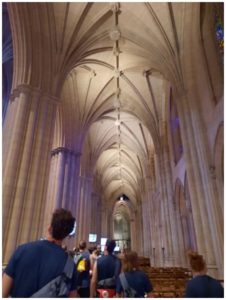 e dim lighting allows for a colorful atmosphere, as the sunlight shines through the stained glass, cascading a rainbow of colors onto the tile floors.
e dim lighting allows for a colorful atmosphere, as the sunlight shines through the stained glass, cascading a rainbow of colors onto the tile floors.
As I think back to touring the cathedral, my memory adds music to the peaceful quiet of the space. A soft, instrumental. It plays as I remember staring at the artwork and craftsmanship that adorned the walls, ceilings, and floor. Though it’s not truthful to the experience, I don’t mind the addition when I imagine myself back inside the cathedral.
Arlington Cemetery was one of the… odder places we visited. I understand its historical importance, and trust me, I saw the impressive, rigorous procedure of the guards at the Tomb of the Unknown Soldier that draws so many people to the cemetery daily.
 But during the time of the time of our tour, there were 26 funerals going on within the cemetery. And though we did respect nearby funeral processions by way of silence, I still felt out of place and an intruder. While other tourists and I gathered to watch and video-tape the changing of the guard, over two dozen families were in mourning.
But during the time of the time of our tour, there were 26 funerals going on within the cemetery. And though we did respect nearby funeral processions by way of silence, I still felt out of place and an intruder. While other tourists and I gathered to watch and video-tape the changing of the guard, over two dozen families were in mourning.
I understand that I was doing no harm by visiting and touring the cemetery, and many others were also there at the same time as me. But, morally it felt wrong. I can’t explain it very clearly, but I think I have somewhat gotten my feelings across.
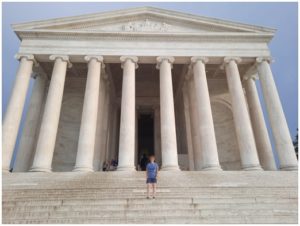 The first major monument we visited was the Lincoln Memorial. I’m not ashamed to admit I rushed up the stairs like a gleeful little child. Before I entered the monument, however, I took a moment to stand at the spot where MLK delivered his “I Have A Dream” speech.
The first major monument we visited was the Lincoln Memorial. I’m not ashamed to admit I rushed up the stairs like a gleeful little child. Before I entered the monument, however, I took a moment to stand at the spot where MLK delivered his “I Have A Dream” speech.
Despite the blazing sunlight, I gazed out across the pool of reflection, and imagined the entire space packed with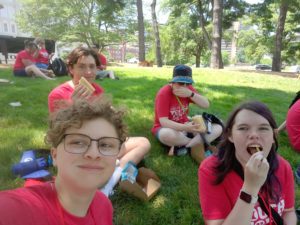 thousands upon thousands of people. I imagined the overwhelming sense of unity and passion, as so many gathered to rally in support of the Civil Rights Movement. Standing in the space felt a lot more powerful than any lesson I received in school.
thousands upon thousands of people. I imagined the overwhelming sense of unity and passion, as so many gathered to rally in support of the Civil Rights Movement. Standing in the space felt a lot more powerful than any lesson I received in school.
Being inside the memorial was like entering the temple dedicated to an American deity. Quotes and speeches carved into the wall like prayers, and the paintings above them painting stories like hieroglyphics. And Abraham Lincoln himself, sat in a chair
prayers, and the paintings above them painting stories like hieroglyphics. And Abraham Lincoln himself, sat in a chair  overlooking the entrance to his temple with a content, yet thoughtful look on his face.
overlooking the entrance to his temple with a content, yet thoughtful look on his face.
Walking along the outside of the memorial, and noticing locals having a picnic at the base of this iconic monument, was the moment I wanted to live in Washington DC. Not only being able to see these astounding works of architecture on a daily basis, but also being able to become so comfortable with them, is something I long to experience, and a thought that I held onto throughout and after the trip.
The Martin Luther King memorial is a towering force to be reckoned with, like the man it honors. The symbolism of the memorial is insanely elaborate and intriguing.
The memorial is carved to resemble stone, with a section pushed forward in which MLK is carved into, representing the mountains he and the other leaders of the Civil Rights Movement moved. The carving remains unfinished, leaving his legs and feet embedded in uncarved rock, representing his unfinished work and progress that is still to come.
A body of water separates him from the memorial of Jefferson– A body of water that could represent the divide between the rights Thomas Jefferson stated all men should receive and the ones the African-Americans were given. His eyes gaze towards Jefferson in disdain, knowing the lack of truth in the founding father’s words. The sheer size of the memorial is astounding, but the symbolism makes it even more powerful.
Walking through the many different parts of the FDR memorial was more sobering than the other Presidential memorials and monuments. Franklin Delano Roosevelt is not immortalized in bronze inside a giant temple or remembered by a giant obelisk that can be seen throughout the entire city. No, his memorial is a simple, four room walkabout sheltered by trees on the shore side. And it is still as powerful as the others; More so in fact.
 Compared to the other presidential memorials, FDR’s is not idolizing the man in the oval office, but humanizing him. Life sized and realistic statues show the person behind the presidential seal– From a
Compared to the other presidential memorials, FDR’s is not idolizing the man in the oval office, but humanizing him. Life sized and realistic statues show the person behind the presidential seal– From a  statue of him listening to the radio as he struggled to pull the country through the depression, to a statue of his dog, Fala– the memorial shows tiny tidbits of his life no other presidential memorial expresses.
statue of him listening to the radio as he struggled to pull the country through the depression, to a statue of his dog, Fala– the memorial shows tiny tidbits of his life no other presidential memorial expresses.
I was more grateful to FDR than I was before I came to the Youth Tour. A few days before I departed for DC, I realized how President Roosevelt’s creation of the Rural Electrification Administration in 1935 has affected my family for generations.
My farm was one directly affected by the rural electrification act. My grandfather spent the first six or so years of his life, with lanterns for interior lighting, and a well and 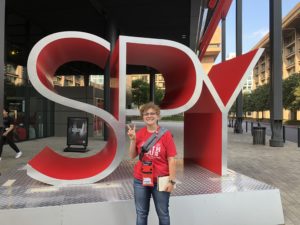 outhouse for plumbing. My grandfather remembers when electricity came to our farm, and how much it changed their way of life.
outhouse for plumbing. My grandfather remembers when electricity came to our farm, and how much it changed their way of life.
And even now, over 50 years later, the creation of the REA is still providing opportunities for people young and old. Two years ago, when COVID-19 shut down my school, I felt the effects of poor broadband and WiFi connection while trying to conduct my education online. But because of the REA, rural electric cooperatives are able to work on a smaller scale to create big changes to rural  communities. And now, quality broadband accessibility is being advanced and offered more and more to people all across the country, making it easier for them to work from home.
communities. And now, quality broadband accessibility is being advanced and offered more and more to people all across the country, making it easier for them to work from home.
Because of FDR and the rural electrification act, the way my farm operated, and thousands across the country, was drastically changed forever. Because of FDR, lives are still being changed all across rural America. I don’t think I’ve ever been able to personally appreciate the acts of a specific president in office before, and that is a piece of gratitude I will hold onto for the rest of my life.
Overall, this truly was a trip of a lifetime. Even with the sleep deprivation and the sunburn, I had the time of my life. It has now been a week since I left DC, but I still lie awake trying to remember every little detail. I think about the people I met, run through a list of their names; The places I went, and how each one made me feel; I especially remember the sunrise I shared with my friends on that final Sunday
my life. It has now been a week since I left DC, but I still lie awake trying to remember every little detail. I think about the people I met, run through a list of their names; The places I went, and how each one made me feel; I especially remember the sunrise I shared with my friends on that final Sunday 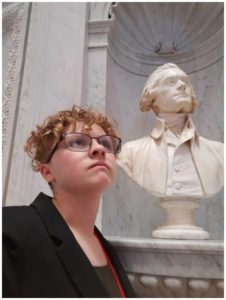 morning.
morning.
But most of all, over the past week, when it’s late at night and I find myself too restless to sleep, I remember the noises of the city and the view of my hotel room. And an overwhelming feeling of whimsy and joy washes over me, and I find myself at peace, all because of my time in Washington DC.